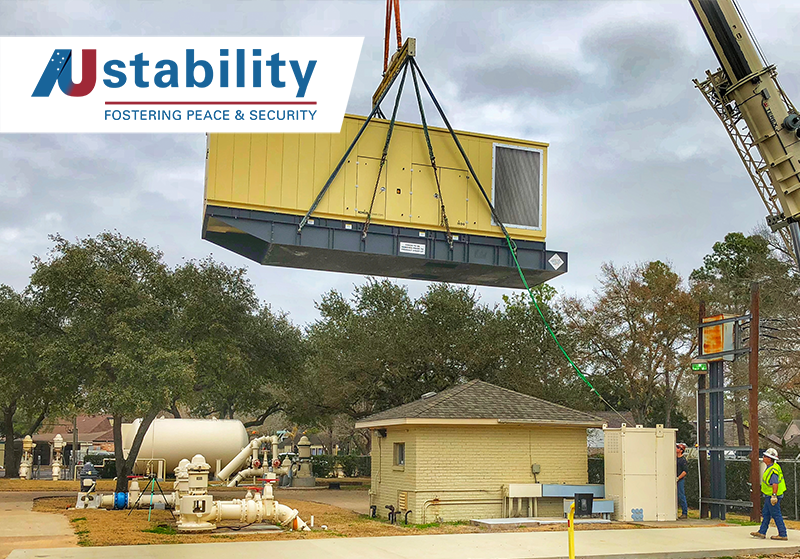Why Mission-Critical Energy Needs a New Approach
Mission critical power in military operations – ensuring uninterrupted electricity for bases, command centers, radar systems, cyber operations, and forward operating units – faces unique challenges that demand a new approach.
By: Tom McCroskey, President & CEO Austability Power Generation
Given traditional reliance on diesel generators, grid connections, and legacy battery systems is increasingly untenable due to evolving threats, operational demands, and strategic shifts, global defense and national security group, Austability, is establishing Austability Power Generation – a potentially game-changing solution to meet the mission-critical energy challenges ahead.
Here are five key reasons why a new approach is essential:
1. Escalating Threats and Vulnerabilities
Military power systems are prime targets for cyberattacks, with state actors (e.g., China, Russia) and non-state groups exploiting vulnerabilities in grid-dependent or networked infrastructure. Recent incidents, like ransomware targeting U.S. base utilities in 2024, show how information technology and operational technology (IT/OT) convergence risks cascading failures. Physical attacks, such as drone strikes on fuel depots, disrupt diesel supply chains critical for generators.
In theaters like the Indo-Pacific, long supply lines for fuel (e.g., 70% of U.S. military logistics is fuel-related) are vulnerable to interdiction. China’s anti-access/area denial (A2/AD) strategies, including missile barrages, threaten fuel resupply, making self-sufficient power critical.
Adversaries’ use of EMP (electromagnetic pulse) or directed-energy weapons can disable traditional power electronics, necessitating hardened, resilient systems.
2. Operational Demands in Dynamic Battlefields
Modern military operations rely on power-hungry technologies—AI-driven command systems, laser defenses, radar arrays, and electrified vehicles (e.g., hybrid JLTVs). For example, a single forward operating base (FOB) can require 1-2 MW, equivalent to a small town, with peaks during combat ops.
Expeditionary environments demand rapidly deployable, modular power solutions. Legacy diesel generators (e.g., 60 kW TQG units) are heavy (2-3 tons), noisy, and require frequent refueling, slowing down agile operations like those in USMC’s Force Design 2030.
Acoustic and thermal signatures from diesel gensets expose positions to enemy sensors. Quiet, low-heat solutions are critical for stealth in contested zones.
3. Sustainability and Strategic Independence
The U.S. military consumes 10 million gallons of fuel daily, with 60% for power generation at bases. This reliance on fossil fuels ties operations to volatile global markets and long logistics tails, costing $1 billion annually in transport alone (2024 estimates). Hostile actors can exploit this dependency by targeting supply routes.
US Department of Defense (DoD) mandates, like the 2022 Climate Adaptation Plan, push for net-zero emissions by 2050, with interim goals for 50% reduction by 2030. Diesel generators, emitting 10-15 kg CO2/kWh during use and testing, clash with these goals and public scrutiny.
Bases with self-sustaining power (e.g., via microgrids) can operate independently, reducing reliance on host nation grids, which may be compromised or controlled by adversaries (e.g., in NATO-allied countries with Russian influence).
4. Supply Chain and Infrastructure Constraints
The civilian AI boom has strained supplies of transformers, switchgear, and power electronics, with lead times stretching to 3-5 years in 2025. Military procurement, despite priority, competes with hyperscalers, delaying upgrades to base infrastructure.
Many military bases rely on 20-30-year-old generators and UPS systems, prone to failure under high cycling. For example, 40% of DoD’s 2,000+ generators require overhaul, per 2024 maintenance reports, increasing downtime risks.
In austere environments (e.g., Pacific islands), lack of local infrastructure demands portable, scalable power solutions that don’t rely on frequent resupply.
5. Evolving Mission Requirements
Concepts like the USMC’s Expeditionary Advanced Base Operations (EABO) require small, dispersed units with independent power for weeks or months. Traditional systems can’t scale down effectively without sacrificing reliability.
Bases face increasing extreme weather—hurricanes, heatwaves, and floods—disrupting grids and fuel deliveries. For instance, Tyndall AFB’s $3 billion rebuild post-Hurricane Michael (2018) highlighted the need for storm-proof microgrids.
Power systems must support both kinetic (e.g., missile defense) and non-kinetic (e.g., cyber ops) missions simultaneously, requiring flexible, high-capacity solutions that can pivot between priorities.
Emerging Solutions for a New Approach
To address these challenges, the military must adopt innovative power systems that enhance resilience, mobility, and sustainability:
Microgrids and Hybrid Systems
Deployable microgrids with solar, wind, and advanced batteries (e.g., lithium-iron-phosphate with 5,000+ cycles) reduce fuel needs by 50-70%. Examples include the Army’s Tactical Microgrid Standard, tested at Fort Hunter Liggett in 2024, which cut diesel use by 60%.
Hydrogen Fuel Cells
Zero-emission, silent, and low-heat, hydrogen cells (e.g., GM’s 300 kW units) offer scalable power for FOBs. They use green hydrogen from on-site electrolysis, cutting logistics risks. The Army’s H2F2 program is scaling this for 2026 deployments.
Bidirectional Power and Energy Storage
Systems that export power to local grids or vehicles (e.g., V2G with electric MRAPs) turn bases into energy hubs, enhancing resilience and generating revenue during peacetime.
Hardened, Modular Electronics
Next-gen power electronics with EMP-resistant designs and rapid setup (under 2 hours) support mobile ops. The Navy’s 2025 trials of solid-state transformers showed 30% efficiency gains over legacy systems.
AI-Optimized Energy Management
AI-driven systems optimize power allocation across mission needs, predicting demand spikes (e.g., during drone swarm defense) and reducing waste. DARPA’s 2024 Energy Web program demonstrated 20% fuel savings in simulated scenarios.
Conclusion
Mission critical power in military operations needs a new approach because traditional systems—diesel-heavy, grid-dependent, and static—are mismatched to modern threats, operational tempos, and strategic goals.
The Austability Group recognizes the challenges ahead and has established Austability Power Generation, to deliver cutting-edge solutions to industry and government partners that incorporate the shift to hybrid microgrids, hydrogen fuel cells, and AI-managed systems.
By 2030, these solutions could cut fuel use by 50%, enhance stealth, and enable independent operations in contested environments, ensuring mission success in an era of great power competition.
To find out more, please get in touch with Austability Power Generations President and CEO, Tom McCroskey tom.mccroskey@auspowergen.com




